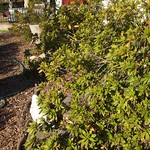Garden Inventory is a series where I begin an inventory of all the plants and trees in my garden. Along with some of my own pictures, I will link to various sources of information about each plant and tree so we can learn a little more together.
I would also like to highlight your special plants and tress. Pass along your favorite plants in the comments and I will use them for future Garden Inventory posts. — Douglas
Garden Inventory: Azalea
“Azaleas (pron.: /əˈzeɪliə/) are flowering shrubs comprising two of the eight subgenera of the genus Rhododendron, Tsutsuji (evergreen) and Pentanthera (deciduous). Azaleas bloom in spring in the Northern hemisphere and in winter in the Southern hemisphere, their flowers often lasting several weeks. Shade tolerant, they prefer living near or under trees.” — Wikipedia.org
This house came with a veritable boat-load of azalea. The previous owners obviously loved the, as much as they loved trees. There are a variety of naturalistic plantings featured along the house foundation and then a series of geometric beds, shaped into triangles, that contained heavy plantings of azalea and juniper. These were kept close-cropped, using hedge trimmers.
Unfortunately, these triangular beds have suffered heavily over the years from bad pruning habits, overcrowding and drought. We have removed 2 complete beds so far and will probably end up removing nearly all of them eventually. The junipers, especially, died under the onslaught of the spreading azalea. In some cases, I am preserving 2-3 azalea in each bed and “re-naturalizing” them — allowing them to spread out naturally instead of trying to prime them into a specific shape.
All of my azalea are pink, as can be seen the photos, but they also come in white, and red varieties. Mine all bloom around this time of year every year, although there was at least one year when I pruned at the wrong time and reduced my blooms to nearly nothing. I have since learned that you should prune them as soon as the current flowering ends so that you don’t accidentally chop off all the buds forming for the next season.
Azalea can look both vibrant and yet exceedingly delicate when you inspect the center of the flower with its filament-like stamen and pistils.
Azalea will propagate themselves fairly easily using a technique know as layering. Wherever a branch touches appropriate soil, roots can form, allowing you to eventually trim off the newly formed plant for use elsewhere in your garden. (See Propagating Azaleas using Layering for more info)
Photos of Azalea plant with closeups of leaves, flowers and stems
More information on Azalea:
- Azalea at Wikipedia.org
- Azalea Society of America
- Azalea Questions and Answers from The United States National Arboretum
- Azalea Garden at New York Botanical Garden
Previously on Garden Inventory:





